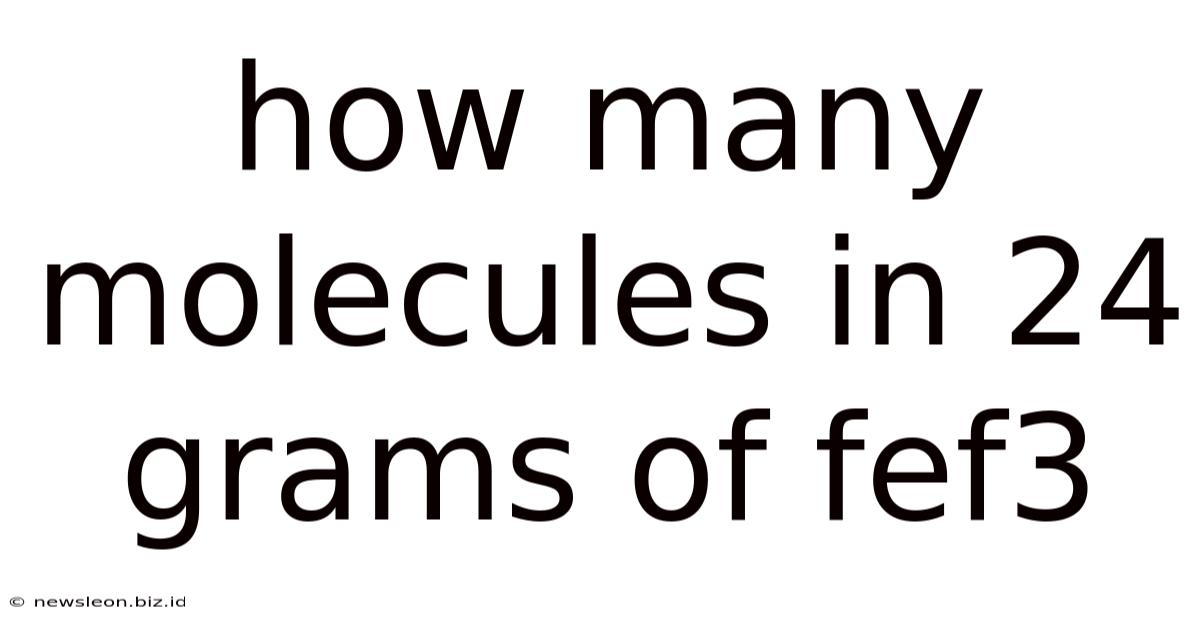How Many Molecules In 24 Grams Of Fef3
News Leon
May 04, 2025 · 5 min read

Table of Contents
How Many Molecules Are There in 24 Grams of FeF₃? A Deep Dive into Molecular Calculations
Determining the number of molecules in a given mass of a compound requires a fundamental understanding of chemistry, specifically molar mass, Avogadro's number, and stoichiometry. This article will guide you through the step-by-step calculation to find the number of molecules in 24 grams of iron(III) fluoride (FeF₃), providing a detailed explanation of the concepts involved and addressing potential points of confusion.
Understanding the Fundamentals
Before we dive into the calculation, let's review some key concepts:
1. Molar Mass
The molar mass of a compound is the mass of one mole of that substance. A mole is a unit of measurement in chemistry that represents Avogadro's number (approximately 6.022 x 10²³) of particles (atoms, molecules, ions, etc.). The molar mass is expressed in grams per mole (g/mol).
To calculate the molar mass of FeF₃, we need the atomic masses of iron (Fe) and fluorine (F) from the periodic table. The atomic mass of iron is approximately 55.85 g/mol, and the atomic mass of fluorine is approximately 19.00 g/mol. Therefore, the molar mass of FeF₃ is:
FeF₃ molar mass = (1 × 55.85 g/mol) + (3 × 19.00 g/mol) = 112.85 g/mol
2. Avogadro's Number
Avogadro's number (Nₐ) is a fundamental constant in chemistry, representing the number of constituent particles (atoms, molecules, ions, etc.) in one mole of a substance. Its value is approximately 6.022 x 10²³ particles/mol.
3. Stoichiometry
Stoichiometry is the quantitative relationship between reactants and products in a chemical reaction. In our case, we'll use stoichiometry to relate the mass of FeF₃ to the number of molecules.
Calculating the Number of Molecules in 24 Grams of FeF₃
Now, let's proceed with the calculation:
-
Convert grams to moles: We'll use the molar mass of FeF₃ to convert the given mass (24 grams) into moles.
Moles of FeF₃ = (Mass of FeF₃) / (Molar mass of FeF₃)
Moles of FeF₃ = 24 g / 112.85 g/mol ≈ 0.213 moles
-
Convert moles to molecules: We'll use Avogadro's number to convert the number of moles of FeF₃ into the number of molecules.
Number of molecules = (Moles of FeF₃) × (Avogadro's number)
Number of molecules ≈ 0.213 moles × 6.022 x 10²³ molecules/mol ≈ 1.28 x 10²³ molecules
Therefore, there are approximately 1.28 x 10²³ molecules in 24 grams of FeF₃.
Understanding the Significance and Applications
This calculation is crucial in various chemical contexts, including:
-
Quantitative Analysis: Determining the number of molecules is essential in analytical chemistry for accurately quantifying substances in solutions or samples. This is particularly important in fields like environmental monitoring, pharmaceutical analysis, and material science.
-
Chemical Reactions: Knowing the number of molecules allows chemists to predict the stoichiometry of chemical reactions and calculate the amounts of reactants and products involved. This is fundamental to designing and optimizing chemical processes.
-
Material Science: In material science, understanding the number of molecules can help determine the properties of materials. The arrangement and interactions of molecules influence properties like strength, conductivity, and reactivity.
-
Pharmaceutical Development: In pharmaceutical development, determining the number of molecules is critical in dosage calculations and understanding drug efficacy and safety. Accurate calculations are paramount for determining therapeutic dosages.
Addressing Potential Errors and Considerations
While the calculation above is straightforward, it's important to acknowledge potential sources of error:
-
Accuracy of Atomic Masses: Atomic masses from the periodic table are usually approximations. Slight variations in the atomic masses used can affect the final result.
-
Significant Figures: Pay close attention to significant figures throughout the calculation. The final answer should reflect the precision of the input values. In this case, using the given value of 24 grams, we are limited to two significant figures in our answer.
-
Purity of the Sample: The calculation assumes that the 24 grams of FeF₃ are pure. If the sample contains impurities, the actual number of FeF₃ molecules will be lower than calculated.
-
Temperature and Pressure (for gases): This calculation is specifically for a solid compound. For gases, temperature and pressure would significantly affect the volume and therefore the number of molecules present.
Expanding the Knowledge: Further Calculations and Applications
We can extend this calculation to explore related concepts and applications. For instance:
-
Calculating the number of atoms of each element: We can determine the number of iron atoms and fluorine atoms separately within the 24 grams of FeF₃. This involves using the stoichiometric ratios from the chemical formula.
-
Calculating the mass of a specific number of molecules: We can reverse the calculation to determine the mass of a specific number of FeF₃ molecules.
-
Applications in different chemical contexts: The principles discussed here can be applied to a vast array of chemical calculations involving different compounds and scenarios.
Conclusion
Calculating the number of molecules in a given mass of a compound, such as the 24 grams of FeF₃ in this example, is a fundamental skill in chemistry. By understanding molar mass, Avogadro's number, and stoichiometry, we can accurately determine the number of molecules and apply this knowledge to various scientific and practical applications. Remember to pay attention to significant figures and potential sources of error to ensure the accuracy of your calculations. This fundamental understanding empowers further exploration of the fascinating world of chemistry and its diverse applications.
Latest Posts
Related Post
Thank you for visiting our website which covers about How Many Molecules In 24 Grams Of Fef3 . We hope the information provided has been useful to you. Feel free to contact us if you have any questions or need further assistance. See you next time and don't miss to bookmark.